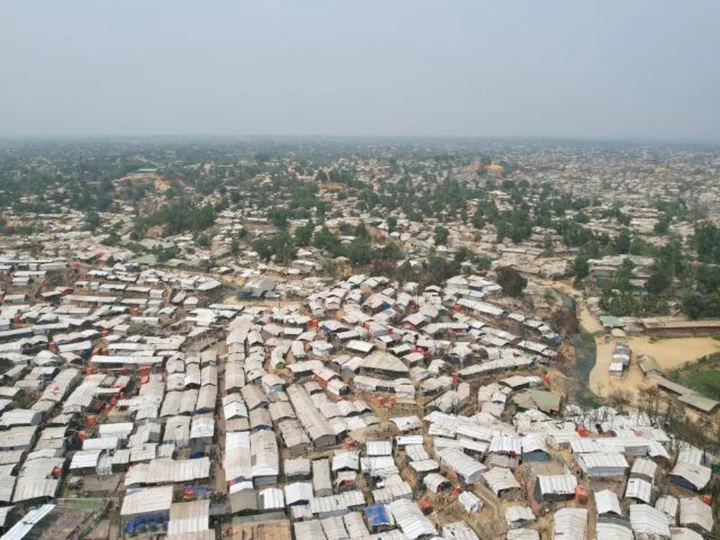Aid agencies in Bangladesh and Myanmar say they are bracing for disaster and have launched a massive emergency plan as a powerful cyclone barrels toward millions of vulnerable people.
Cyclone Mocha, which formed in the Bay of Bengal early Thursday, has rapidly intensified in the past 24 hours and is now the equivalent to a category 3 Atlantic hurricane, according to the Joint Typhoon Warning Center.
The storm is expected to intensify further before making landfall between Kyaukpyu, in Myanmar's western Rakhine state, and southeastern Bangladesh's Cox's Bazar -- host to the world's largest refugee camp -- on Sunday, bringing destructive winds, heavy rain and the threat of storm surges.
Disaster response teams and more than 3,000 local volunteers who have been trained in disaster preparedness and first aid have been put on standby in the camps, and a national cyclone early warning system is in place, according to Sanjeev Kafley, Head of Delegation of the IFRC Bangladesh Delegation.
Kafley said there are 7,500 emergency shelter kits, 4,000 hygiene kits and 2,000 water containers ready to be distributed.
In addition, mobile health teams and dozens of ambulances are ready to respond to refugees and Bangladeshis in need, with specially trained teams on stand by to help the elderly, children and the disabled, Arjun Jain, UN Principal Coordinator for the Rohingya Refugee Response in Bangladesh, told CNN.
"We expect this cyclone to have a more severe impact than any other natural disaster they have faced in the past five years," said Jain. "At this stage, we just don't know where the cyclone will make landfall and with what intensity. So we are hoping for the best but are preparing for the worst."
Evacuations of people in low-lying areas or those with serious medical conditions had begun, he said.
In Myanmar, residents in coastal areas of Rakhine state and Ayeyarwady region have started to evacuate and seek shelter at schools and monasteries.
Hundreds of Red Cross volunteers are on standby and the agency is relocating vulnerable people and raising awareness of the storm in villages and townships, the IFRC's Kafley said.
India's Meteorological Department said Saturday Mocha had intensified into an extremely severe cyclonic storm and forecast a storm surge of up to 2.5 meters (8.2 feet) was likely to inundate low-lying coastal areas in the path of the cyclone at the time of landfall.
Rohingya refugees preparing for the worst
About 1 million members of the stateless Rohingya community, who fled persecution in nearby Myanmar during a military crackdown in 2017, are living in the sprawling and overcrowded camps in Cox's Bazar.
Most live in bamboo and tarpaulin shelters perched on hilly slopes that are vulnerable to strong winds, rain, and landslides.
Jain said the shelters can only withstand wind speeds of 40 kph (24 mph) and he expects winds from Cyclone Mocha to exceed that.
"Low lying areas of the camps are likely to flood rapidly, destroying shelters, facilities such as learning centers, as well as infrastructure such as bridges that have been constructed with bamboo," he said.
The cyclone adds to an already disastrous year for the Rohingya, and without more funds from the international community, Jain said they won't have enough to rebuild.
"They faced a 17% cut in their food rations earlier this year due to funding cuts and we expect a further cut in their rations in the coming months. 16,000 refugees lost their home in a devastating fire in March. And now they must deal with the cyclone. Unfortunately, we don't even have the funds to help refugees rebuild their homes and facilities if the devastation is severe," he said.
There are also concerns for 30,000 Rohingya refugees housed on an isolated and flood-prone island facility in the Bay of Bengal, called Bhasan Char. The UN refugee agency said volunteers and medical teams are on standby and cyclone shelters and food provisions are available for those living on the island.
In Myanmar, about 6 million people are in need of humanitarian assistance in Rakhine state and across the northwest, with 1.2 million displaced, according to the UN humanitarian agency.
Cyclone's track and rapid intensification are part of a worrying climate trend
The past few decades have seen an increase in the strength of tropical cyclones affecting countries in parts of Asia and recent research predicts they could have double the destructive power in the region by the end of the century.
While scientists are still trying to understand ways climate change is affecting cyclones, a slew of research has linked human-caused global warming to more potent and destructive cyclones.
Tropical cyclones (also known as hurricanes, typhoons and tropical storms depending on ocean basin and intensity), feed off ocean heat. They need temperatures of at least around 27 degrees Celsius (80 Fahrenheit Fahrenheit) to form, and the warmer the ocean, the more moisture they can take up.
The waters in the Bay of Bengal are currently around 30 degrees Celsius (86 Fahrenheit Fahrenheit), about 2 degrees Celsius (3.6 degrees Fahrenheit) warmer than average for May.
As the climate crisis pushes up the temperatures of oceans -- which absorb around 90% of the world's excess heat -- it provides ideal conditions for cyclones to gain strength.
Warmer oceans also increase the chances of cyclones rapidly intensifying, according to recent research.
Climate-change fueled sea-level rise adds to the risks, worsening storm surges from tropical cyclones and allowing them to travel further inland.
Bangladesh and Myanmar are particularly threatened because they are low-lying, as well as being home to some of the world's poorest people.

